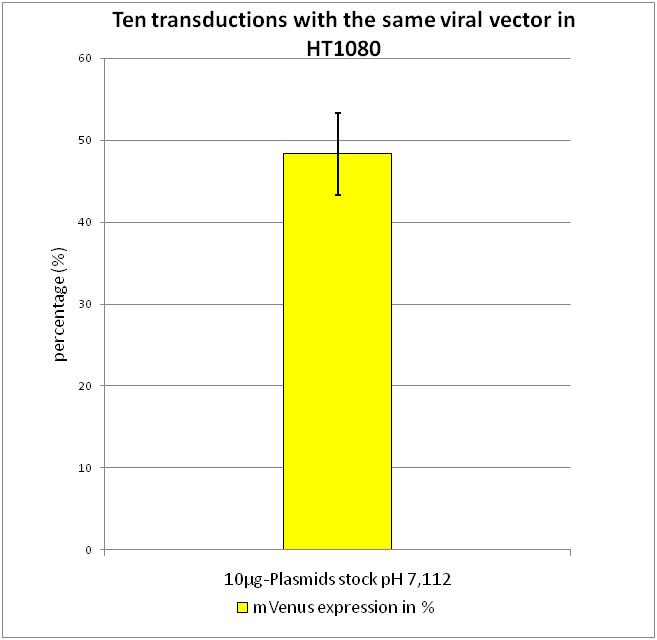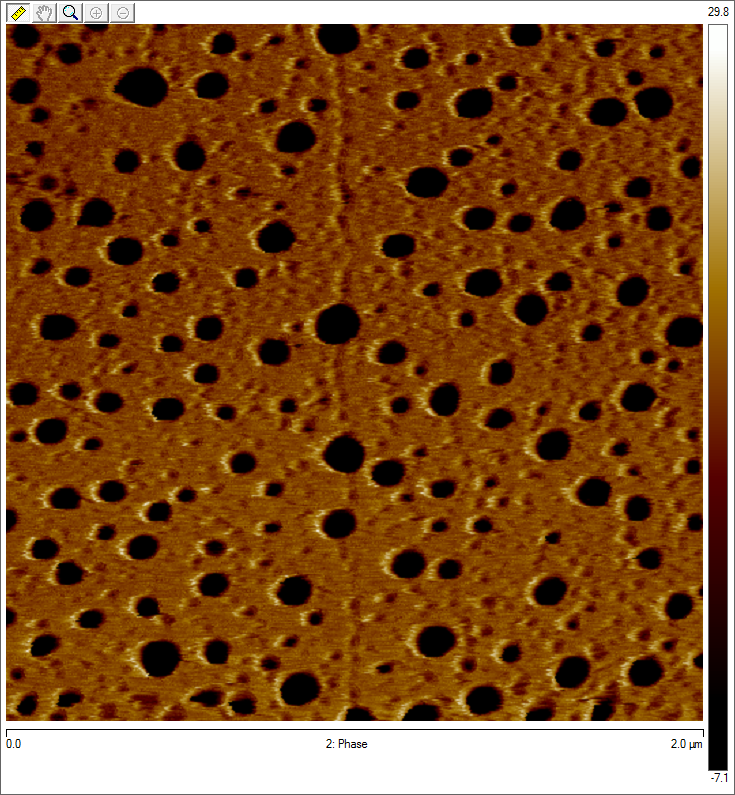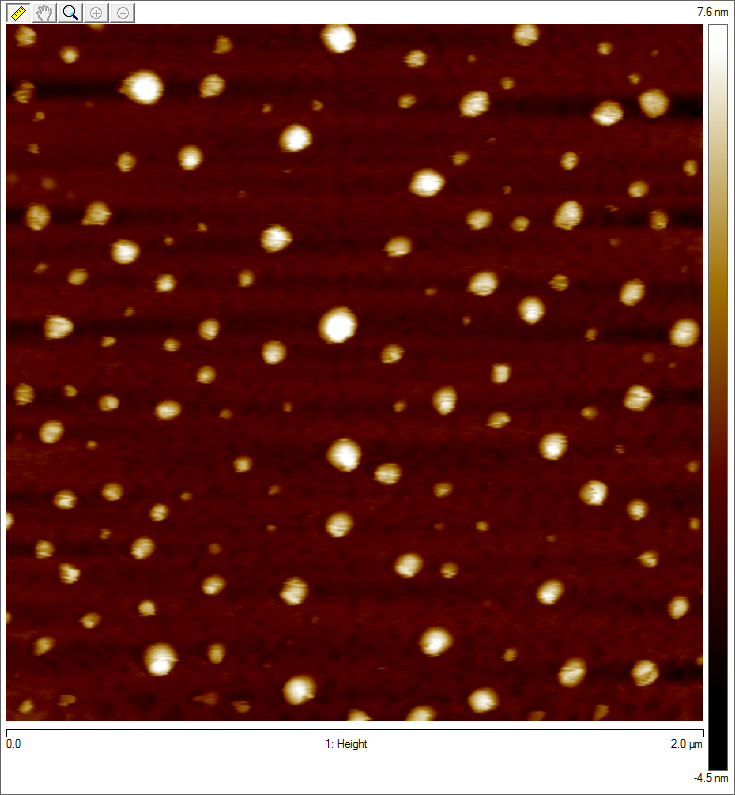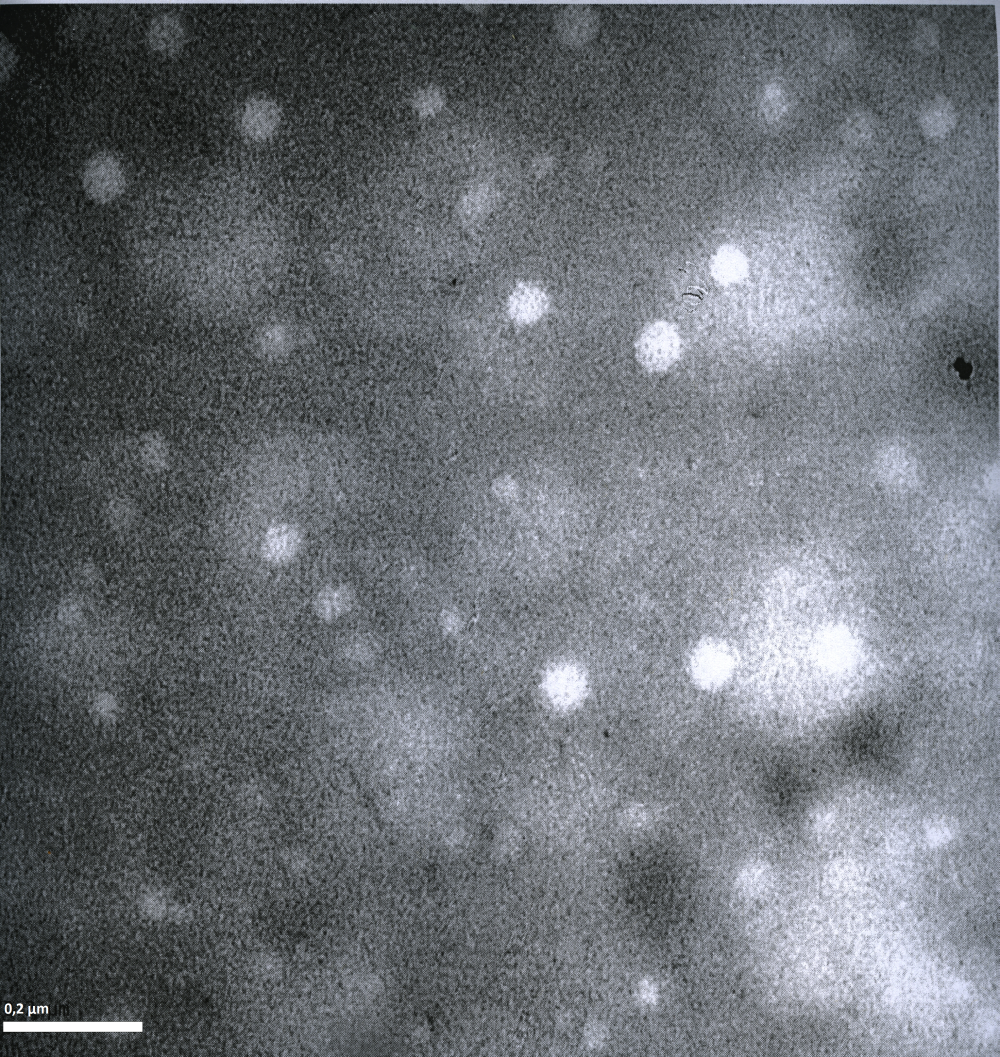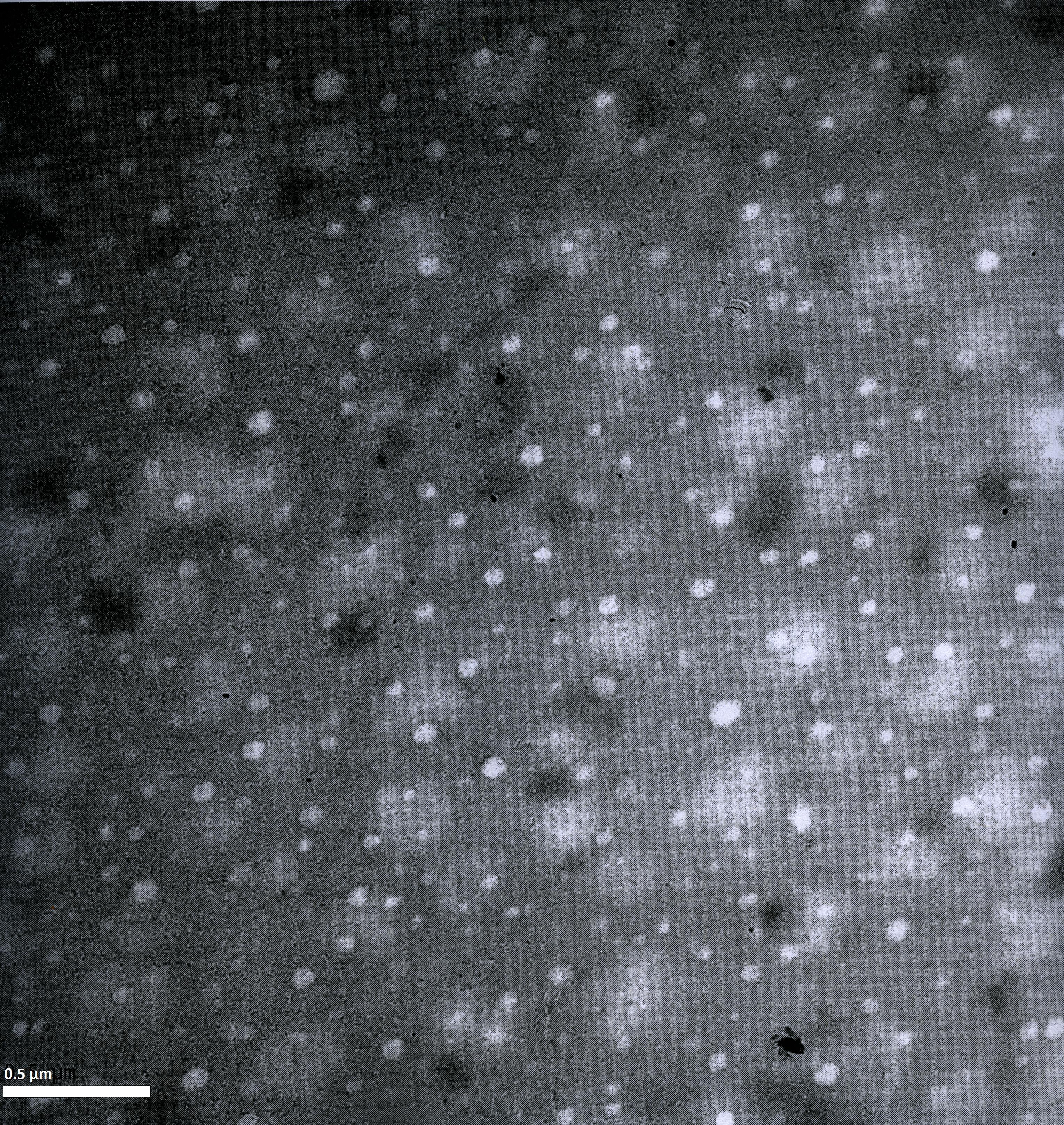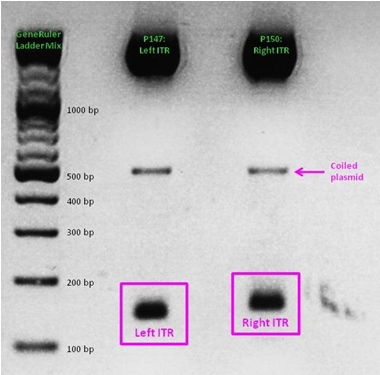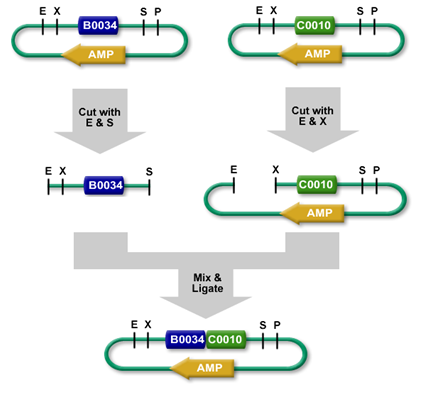Team:Freiburg Bioware/Project/Methods
From 2010.igem.org
(→Established Methods) |
(→Cloning) |
||
| Line 100: | Line 100: | ||
Link to NEB: http://www.neb.com | Link to NEB: http://www.neb.com | ||
| + | |||
| + | ===Site-Directed Mutagenesis=== | ||
| + | The Site-Directed Mutagenesis (SDM) is used to mutate a specific base inside the plasmids sequence (Hutchison et al. 1978). Therefore, forward and reverse primers, which prime at the same site, containing a mismatch at the specific base in terms of the original structure are required. This mismatch defines the new base through which the original one is replaced. | ||
| + | |||
| + | As with Polymerase Chain Reaction, the site-directed mutagenesis works by amplifying the desired construct. The DNA double-strand is heat-denaturated which allows primers to bind to the single-stranded sequences after lowering the temperature. Designing a mismatch within the primers sequence leads to replacement of the unwanted base in later cycles of denaturating, annealing and elongation strands. After SDM program is finished, digestion with DpnI is necessary to digest parental methylated and hemi-methylated plasmid strands which do not contain the desired base pair exchange. For SDM, QuikChange Lightning Site-Directed Mutagenesis Kit (Agilent Technologies, Santa Clara, CA, USA) and QuikChange Site-Directed Mutagenesis Kit (Agilent Technologies) were used. | ||
| + | |||
| + | Link to Agilent: http://www.genomics.agilent.com | ||
| + | |||
| + | ===Ligation=== | ||
| + | [[Image:Freiburg10 Ligation.png|right|thumb|200px]] | ||
| + | Through restriction enzymes digested plasmid fragments can be reassembled into a new vector by ligation (see: Digestion). Ligase (Lehman 1974) connects complementary overhangs of fragments originated from digestion. The 5´phosphoryl group is bound to the hydroxyl group of the 3´end and therefore connects the fragments via ligase. This reaction requires energy whose form depends on ligase used. T4 DNA Ligase for example requires ATP. | ||
| + | This new vector now holds the genetic information of both the opened vector (minus the cut out fragment), and the insert. | ||
=Protocols; Standard Operating Procedures= | =Protocols; Standard Operating Procedures= | ||
Revision as of 21:10, 27 October 2010
Methods
Contents |
Method Development
Purification of AAV particles
IMAC purification via Viral Brick: The Histidin Affinity Tag
Protein tagging via Histidine Tags is a widely used method for protein purification: Multiple histidine residues (most commonly: Six) are being fused tot he end of the targeting protein. The high binding affinity of Histidine towards metal is being exploited for the purification of proteins via the so called „Immobilized Metal Ion Affinity Chromatography“ (IMAC): Multiple histidine residues (most commonly: Six) are being fused to the end of the targeting protein. A cell extract containing the recombinant protein ist then applied to a collumn containing immobilized Ni2+-Ions. The His-tags covalently bind the Ni-Ions while other cellular proteins can be washed oft he collumn. The purified proteins can then be eluted with Imidazol, which displaces the histidine residues.(MC Smith et al. 1988), (Hoffmann and Roeder 1991) Since the aim behind engineering therapeutic AAV vectors is a safe administration to human patients, it is important to consider a convenient way of purifying the virus particles. Contamination by cellular proteins could cause toxic side effects or a strong immune response. (Koerber et al. 2007) have first inserted a His-tag into a surface-exposed loop at amino acid position 587 in the Cap protein and successfully purified recombinant virsuses using IMAC. For our Virus Construction Kit, we provide the His-tag motif in the ViralBrick standard, allowing an easy insertion into the 453 and/or 587 loop.
Specific Biotinylation via ViralBrick: The Biotinylation Acceptor Peptide
The BAP (Biotinylation Acceptor Peptide) that we included in our Virus Construction Kit is a 15 amino acid long peptide identified by Schatz J., 1993 in an library screening approach and published under the number #85. This peptide with the sequence 5' - GLNDIFEAQKIEWHE - 3' contains a central lysine that is specifically biotinylated by the prokaryotic enzyme biotin holenzyme synthetase, encoded in the BirA gene of E. coli. Specific biotinylation of this peptide sequence can be performed in vivo by contransfecting a plasmid with the BirA gene as described for the AAV in Arnold et al.; 2006 or by an in vitro coupling approach using the purified Escherichia coli enzyme biotin ligase (BirA). The purified BirA biotin ligase that was kindly provided by Avidity.
Experiences from under the hood: Cell Culture
Optimizing the transfection protocol
The optimization of the lab intern standard protocols was one of our fields on investigation. Besides optimizing the handling of our different cell lines and working steps, the transfection protocol was examined. One of the most remarkable lessons after several transfection performed was the crucial handling of the AAV293 cells. Once over approximately 80 % confluence the cells are no longer competent for transfection. Another achievement in method development was the determination of the optimal plasmid amounts. The best results were performed using 3.3 µg per plasmid and therefore this parameter was modified in our standard protocol. After transfecting the AAV293 we were able to detect the Ca2+-DNA conglomerates in the medium. The toxic side effects of these conglomerates were also confirmed. Not only the medium had to be changed, but also washing with PBS was essential to keep the cells alive.
The most critical steps in transfection is the exact pH of the 2x Hepes buffered-saline (HBS) buffer, in which the C2+-DNA complexes precipitate. Our initial buffer had a pH of 7.112. To determine the best pH-value for transfection, transfections were performed using buffers with different pH, harvested the viral particles and used the flow cytometry to define the optimal pH. Transfection, harvesting and transducton were performed according to the modified standard protocol.
After confirming that the highest amount of viral particles was created with the pH 7.112 2xHBS we wanted to determine how valid the flow cytometry data is and created a standard derivation.
Flow Cytometry Analysis
After transduction with equal volumes of the created viral stock the flow cytometry was performed according to FACS protocol. As it can be seen there is only a small standard derivation of 6.19% in mVenus positive cells. By combining the results gained from the experiments described above, we were able to evaluate the standard protocol described in Material and Methods.
Imaging AAV: EM/AFM pictures
To visualise our custom AAV particles, we took transmission electron microscopy as well as atomic force microscopy pictures from our virus samples:
AFM
EM
Particles appear too large in size, according to Chen et al. this phenomenon might be due to aggregating particles.
Resources
1. Chen H. Atomic force microscopy of recombinant adeno-associated virus-2 prepared by centrifugation. Scanning. 29(5):238-42. Available at: http://www.ncbi.nlm.nih.gov/pubmed/17828711.
ITR cloning
As a part of our modularization of the AAV vector plasmids, we needed to extract the sequences making up the ITRs at each end of the vector and clone them into an IGEM-compatible backbone. But due to the ITRs’ strong secondary structures, none of our PCR-based approaches worked. External companies weren’t able to synthesize or even sequence the ITRs. Taking advantage of NotI and PstI restriction sites flanking the ITRs, we worked out a complex cloning strategy that finally led to functional ITR motives in the rfc10 standard.
See also: Hannas' ITR Diary
Serum-free cell culture medium
Introduction
Serum-free mediums allow users to standardize their cell culture conditions. It contains no animal proteins or animal-origin constituents, e.g. FCS (fetal calf serum).
The AAV-293 cells are used for AAV-2 production and are usually grown in (among other chemicals, such as nutrients, antibiotics, growth factors) serum supplemented DMEM medium. Regarding Western Blots, size exclusion chromatographies and other (purification) methods, the undefined and also highly variable serum products can disturb or interfere with these methods. Therefore it is useful for many applications to grow AAV-293 cells in serum-free medium.
Because our long term goal for AAV vectors is application in human patients, we are also trying to develop new methods to produce pure, uncontaminated AAV particles. The use of FCS to supplement cell culture medium for AAV particle production is problematic because even smallest amounts of animal antigens in the administered drug could lead to a strong immune response in patients.
Testing serum free medium
Serum free medium was obtained from AAV-293 cells are not adapted to serum-free growth conditions so we had to accustom them to the new growth conditions step by step, starting with 25% serum-free medium, e.g. 15 ml DMEM (not serum-free) + 5 ml serum-free medium (FreeStyle™ 293 Expression Medium) for a T75 flask. Each step takes at least 1 passage. We raised the serum-free ratio to 100 % over 7 passages.
100% serum-free cells grow slower compared to the serum-supplemented ones and we had to check them regularly via microscopy because the medium contains no pH indicator.
Results
Even though cells grew slower and handling was more difficult due to a missing pH indicator, we successfully cultivated AAV-293 cells in serum-free medium. The cells were used for AAV production, and we produced similar amounts of virus particles compared to cells grown in FCS-supplemented medium. Production efficiency can’t be compared exactly because after seeding cells for transfection they don’t grow as fast as the AAV-293 in serum containing medium.
Established Methods
Cloning
Polymerase Chain Reaction
The Polymerase Chain Reaction (PCR) is a technique to amplify specific DNA sequences delivered by a DNA template independent from a bacterial system. Especially designed primers encompass the desired sequence. These primers serve as docking regions for the polymerase which extends the newly synthesized DNA strand.
The DNA template strand is heat denaturated (98 °C, 1 minute) to produce single-stranded DNA. The next step requires the temperature to be lowered to a temperature at which forward and reverse primers are able to anneal to their complementary bases on the DNA template. This temperature is defined by the length and the GC content of the primers. With increasing temperature (72 °C) the polymerase binds the priming regions and elongates the primers. The temperature is raised again to denaturate the double strand and the cycle starts anew.
PCRs were performed using Mastercycler gradient (Eppendorf, Hamburg, Germany), Mastercycler personal (Eppendorf) and Px2 ThermoHybaid devices (Thermo Fisher, Waltham, MA, USA). PhusionTM Polymerase together with corresponding buffer and dNTP mix were obtained from New England Biolabs (New England Biolabs, Ipswich, MA, USA).
Link to NEB: http://www.neb.com
Site-Directed Mutagenesis
The Site-Directed Mutagenesis (SDM) is used to mutate a specific base inside the plasmids sequence (Hutchison et al. 1978). Therefore, forward and reverse primers, which prime at the same site, containing a mismatch at the specific base in terms of the original structure are required. This mismatch defines the new base through which the original one is replaced.
As with Polymerase Chain Reaction, the site-directed mutagenesis works by amplifying the desired construct. The DNA double-strand is heat-denaturated which allows primers to bind to the single-stranded sequences after lowering the temperature. Designing a mismatch within the primers sequence leads to replacement of the unwanted base in later cycles of denaturating, annealing and elongation strands. After SDM program is finished, digestion with DpnI is necessary to digest parental methylated and hemi-methylated plasmid strands which do not contain the desired base pair exchange. For SDM, QuikChange Lightning Site-Directed Mutagenesis Kit (Agilent Technologies, Santa Clara, CA, USA) and QuikChange Site-Directed Mutagenesis Kit (Agilent Technologies) were used.
Link to Agilent: http://www.genomics.agilent.com
Ligation
Through restriction enzymes digested plasmid fragments can be reassembled into a new vector by ligation (see: Digestion). Ligase (Lehman 1974) connects complementary overhangs of fragments originated from digestion. The 5´phosphoryl group is bound to the hydroxyl group of the 3´end and therefore connects the fragments via ligase. This reaction requires energy whose form depends on ligase used. T4 DNA Ligase for example requires ATP. This new vector now holds the genetic information of both the opened vector (minus the cut out fragment), and the insert.
Protocols; Standard Operating Procedures
Standard Protocol: Cloning
Media:Freiburg10_Advanced_Cloning_Protocol_04_08_2010.pdf
Media:Split_cellculture.pdf
Media:Freeze_cellculture.pdf
Media:production of competent E.coli.pdf
Media:Freiburg10_Transfection_protocoll.pdf
Media:Freiburg10 Thawing cells.pdf
Media:Freiburg10_Aminoacids_vs_restrictionsites.pdf
Media:Freiburg10 Endotoxinfreie Midi.pdf
Media:Freiburg10_LB+Agar.pdf
Media:Freiburg10_Subcloning_cap_into_pAAV_RC.pdf
Media:Freiburg10_Quantitative_realtime_PCR_for_Titering_of_infectious_AAV_particles.pdf
 "
"

